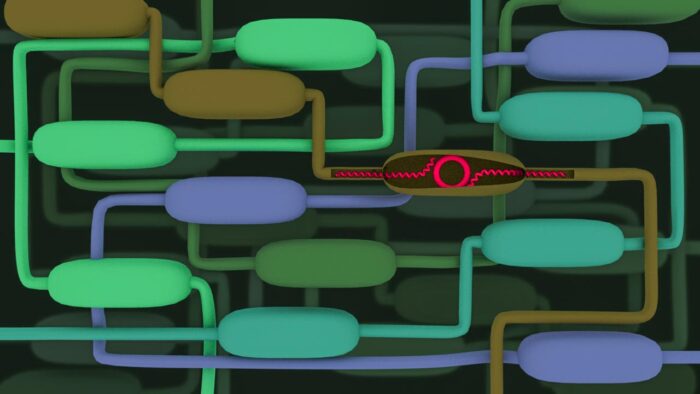Team engineers first synthetic organism that ‘speaks a different language’ by refactoring the genetic code

The genetic code – the rules by which genetic information is encoded in genes within DNA – is near-universal across all kingdoms of life, enabling the transfer of genetic information and innovation between diverse cells. Biologists have long made use of the common code for engineering microbes, crops, and animals.
Now, Jason Chin’s group in the LMB’s PNAC Division have altered the rules by which genetic information is encoded in DNA, creating genetically isolated organisms which cannot exchange genetic information with the environment. This provides a new paradigm which both protects valuable engineered organisms from natural invaders and safeguards the natural world from engineered genetic material.
Jason’s group previously developed methods to synthesise the genome of Escherichia coli (E. coli), creating Syn61, an organism with a compressed genetic code, and a further engineered organism, Syn61delta3, in which two transfer RNAs (tRNAs) and one release factor had also been deleted.
Syn61delta3 cells are resistant to a range of viruses because they are unable to read viral genomes that use the full genetic code. However, the team hypothesised that it was possible for mobile genetic elements – including transposons, viruses and plasmids – to complement the missing tRNAs, thereby making Syn61delta3 susceptible to viral infection. In addition, it is possible that genetic information from synthetic organisms could be shared with natural cells via horizontal gene transfer.
To address these issues, Jerome Zürcher, a PhD student in Jason’s group, engineered tRNAs to re-assign the codons that were removed when Syn61 was synthesised to different natural amino acids in Syn61delta3, refactoring the structure of the genetic code.
Jerome demonstrated that genes which use the new synthetic code could only be correctly read in cells which have the cognate tRNAs. Natural genes could not be correctly decoded in the synthetic cells in which codons had been reassigned, and natural cells could not correctly read synthetic genes written in the altered code. The natural cells and synthetic cells, therefore, cannot share genetic material horizontally as they each ‘speak’ a different genetic language.
To test whether the newly engineered cells were resistant to viral infection, the team collaborated with George Salmond’s group in the University of Cambridge Department of Biochemistry. Together they identified pools of bacterial virus from the local River Cam that can infect Syn61delta3. When the cells with refactored genetic codes were challenged with these virus strains, no viral infection occurred, demonstrating that cells with refactored genetic codes are protected from the invasion of mobile generic elements.
By refactoring the genetic code, the team have engineered cells that have a genetic firewall isolating the synthetic organisms from the environment. Viral resistance is important when utilising engineered cells to manufacture drugs and materials. If a virus gets into the vats of bacteria used to manufacture certain drugs, such as insulin, then it can destroy the whole batch, disrupting vital supply chains. Such genetic firewalls are also particularly important when considering applications outside of the laboratory, such as in agriculture.
The work was funded by UKRI MRC and UKRI BBSRC.
 This project has received funding from the European Union’s Horizon 2020 research and innovation programme under grant agreement No 897663.
This project has received funding from the European Union’s Horizon 2020 research and innovation programme under grant agreement No 897663.
Further references
Refactored genetic codes enable bidirectional genetic isolation. Zürcher, JF., Robertson, WE., Kappes, T., Petris, G., Elliot, TS., Salmond, GPC., Chin, JW. Science, Vol 378, 516-523 (2022)
Science News – Rewritten genetic code allows bacteria to fend off viral attacks
Total synthesis of Escherichia coli with a recorded genome. Fredens, J., Wang, K., de la Torre, D., Funke, LFH., Robertson, WE., Christova, Y., Chia, T., Schmied, WH., Dunkelmann, DL., Beránek, V., Uttamapinant, C., Gonzalez Llamazares, A., Elliot, TS., Chin, JW. Nature, 514-518 (2019)
Sense codon reassignment enables viral resistance and encoded polymer synthesis. Robertson, WE., Funke, LFH., de la Torre, D., Fredens, J., Elliott, TS., Spinck, M., Christova, Y., Cervettini, D., Böge, FL., Buse, S., Maslen, S., Salmond, GPC., Chin, JW. Science, Vol 372, Issue 6546 (2021)
Jason’s group page
George Salmond’s group page
Previous Insight on Research articles
Cells reprogrammed for genetically encoded polymer synthesis and viral resistance
Creating an entire bacterial genome with a compressed genetic code